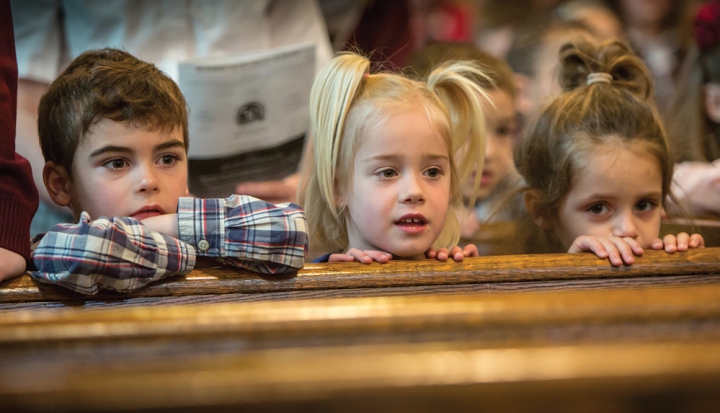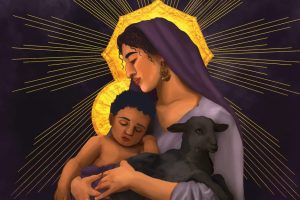At my former parish I was the catechist for second graders, students for whom the chief focus and driving dynamic of the school year was, of course, preparation for first communion. Every lesson, every Sunday, was parsed for its eucharistic significance, though preparation began in earnest once we hit Lent. One morning we took a look at da Vinci’s The Last Supper and talked about the disciples’ reactions and what they might mean. (We had studied enough religious art together by that time that they knew when people in the painting seemed overexcited there must be some major theology going on.) Then we read Matthew’s account of the Last Supper and talked about how during the Mass the priest says the exact same words as Jesus—and how we’re the overexcited disciples around the table. And we pushed a bunch of desks together into a long row and acted out the occasion with Welch’s grape juice and a whole wheat roll that had a passable first-century Palestine feel to it.
But the more difficult part of the preparation is introducing 7-year-olds to the concept of the real presence. It’s difficult because it’s a mystery—Thomas Merton, in his classic reflection on the Blessed Sacrament, The Living Bread (Farrar, Straus and Giroux), calls it “the central mystery of Christianity”—and you can’t teach a mystery. You can point toward it, talk about your own experience of it, say what it’s not. But ultimately the only way you can prepare someone for mystery is by bringing them into its presence and letting them go.
So one Sunday we made a field trip to the side altar where the Blessed Sacrament was reserved. The kids were already curious about it. They had noticed the tabernacle, the sanctuary lamp, the kneelers before the altar, the rows of low chairs behind them. They noticed that people acted different there: quieter, more serious, that they seemed to pray harder there.
A couple of them also noticed that the hosts that were left after communion were put in “the little house,” and I told them this was why people acted different in that part of the church: as Catholics, we believe that the living spirit of Jesus is present in the consecrated bread. People are serious in front of the little house because they’re in the presence of Jesus.
My students loved the field trip. They loved (amazingly enough, for kids that age) being quiet, they loved being serious, and they loved praying hard. Although we had planned to say the Lord’s Prayer as a group, one boy, Jack, asked me, “Can I pray inside my head?” I said of course he could. He went to a kneeler, closed his eyes, prayed, and, I believe, entered adoration—experienced mystery.
Merton writes, “Although the most sublime theology cannot fully explain the mystery by which God gives Himself to us in the Eucharist, the reality of our union with Him is something that can be experienced . . . in its spiritual purity by the mind of the simplest child.” For adults, however, even those in possession of some “sublime theology,” it can be more difficult. I sensed that a number of my second-grade parents were actually a bit uncomfortable about the real presence, almost embarrassed by it. Others, however, thanked me for teaching it. But both reactions indicated a certain distance from it, that it had gone from being an article of the faith to something one had an opinion about. I later came to see that I had my own distancing devices, my own resistance to the immediacy, intimacy, and mystery of the real presence.
I left that parish, an intentional community downtown, about a year ago and became a member of my neighborhood parish. An enthusiastic newcomer, I was checking the bulletin one Sunday to see what I might get involved in, and noticed that on Wednesday nights there was a Holy Hour.
Truth be told, I hadn’t been to a Holy Hour since grade school, and my first impulse was to dismiss it as old fashioned. I know myself well enough to know that my abrupt dismissals are a defense mechanism, and I wondered what I was defending myself against. I resolved to go the next Wednesday. I’ve been going every Wednesday since.
Eucharistic adoration emerged from rather heated debates about the real presence back in the 11th century. When these debates were ended with the doctrine of transubstantiation, the elevation of the host became the centerpiece of medieval liturgies—and a template for today’s eucharistic adoration.
Establishment of the Feast of Corpus Christi in 1264 was an indicator of the growing popular appeal of eucharistic devotion. Forty Hours devotion received official recognition some 300 years later, and adoration remains a mainstay of parish devotional life today.
Thomas Merton warns that there are two extremes to be avoided when considering the Blessed Sacrament: on one end, a pious sentimentality and, on the other, the loftier ethers of abstract theology. That first Wednesday night I managed to hit both extremes—within minutes of each other.
As soon as I walked through the door and saw the monstrance on the altar sparkling in the dimly lit church, I felt immensely happy to be there, had a warm sense of grounding, of homecoming. But I also realized that it was a feeling steeped in nostalgia, a page from my devotional scrapbook, an old photo tinted with the hues of my Catholic childhood. Knowing myself to be incapable of sustaining that level of sentimentality for an hour, I caromed from the warm fuzzies of piety to the icy realms of theology.
I thought about Thomas Aquinas, baptizing Aristotle, explaining the real presence as the mystical transmutation of the essence of matter (its “substance”) into the living presence of Christ while retaining its outer qualities (its “accidents”). I thought about Karl Rahner, baptizing Heidegger, positing the real presence as a localized manifestation of the “supernatural existential,” the graced action of God permeating all of existence, less a matter of theology than ontology.
But then, as I knelt a moment in the aisle before getting into my pew, I remembered a saying of Meister Eckhart—“God despises ideas”—and that the point of theology is to bring us to an interior space beyond theology. And my first prayer once I settled in, once I focused on the monstrance, was, “Let me have no distance on this. Let me never figure this out.”
My first prayer—and pretty much my last. The rest of that night, if I said anything, I pretty much just said the name of Jesus. It seemed enough. It still does. Though some Wednesday nights I picture Jack praying next to me, or sometimes kneeling before the monstrance. I ask God to give me the purity of his faith, to let me be a first communicant again, always a first communicant, to move into mystery and let myself go, close my eyes and pray inside my head, joyfully anticipating the first and everlasting taste of Christ.
This article also appears in the January 2018 issue of U.S. Catholic (Vol. 83, No. 1, pages 45–46).
Image: Flickr cc via Roman Catholic Archdiocese of Boston













Add comment